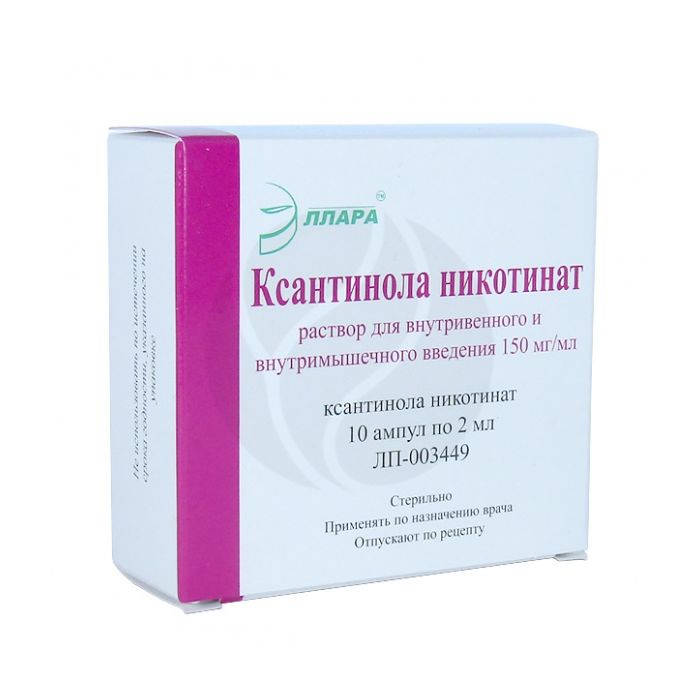Xanthinol nicotinate solution for injection 15%, 2ml No. 10
Expiration Date: 05/2027
Russian Pharmacy name:
Ксантинола никотинат раствор для инъекций 15%, 2мл №10
obliterating atherosclerosis;
endarteritis of the vessels of the lower extremities;
diabetic angiopathy;
retinopathy;
acute thrombophlebitis of superficial and deep veins;
post-thrombophlebitis syndrome;
trophic ulcers of the lower extremities:
bedsores;
Meniere's syndrome;
dermatoses associated with a disorder of vascular trophism;
violation of cerebral circulation.
In acute disorders of tissue blood supply, the drug is administered intramuscularly at 0.3 g (2 ml of 15% solution) 1-3 times / day. Depending on the nature of the disease, the dose can be gradually increased to 0.6-0.9 g (4-6 ml of a 15% solution) 2-3 times / day. The duration of treatment is 2-3 weeks.
In acute disorders of peripheral and cerebral circulation, Xanthinol nicotinate is administered intravenously drip at a rate of 40-50 drops / min. To do this, 1.5 g (10 ml of 15% solution) of the drug is diluted in 200-500 ml of 5% glucose solution or in 200 ml of isotonic sodium chloride solution, the resulting infusion mixture is injected drip for 1.5-4 hours. The infusion can be repeated up to 4 times / days; the duration of treatment is 5-10 days.
Active ingredient : xanthinol nicotinate - 150 mg
Excipients : water d / and (up to 1 ml).
acute heart failure, incl. acute myocardial infarction;
chronic heart failure IIB-III degree;
mitral stenosis;
arterial hypotension;
acute bleeding;
peptic ulcer and duodenal ulcer in the acute stage;
acute renal failure;
glaucoma;
childhood;
pregnancy I trimester;
increased individual sensitivity to the components of the drug.
Dosage regimen
In acute disorders of tissue blood supply, the drug is administered intramuscularly at 0.3 g (2 ml of 15% solution) 1-3 times / day. Depending on the nature of the disease, the dose can be gradually increased to 0.6-0.9 g (4-6 ml of a 15% solution) 2-3 times / day. The duration of treatment is 2-3 weeks.
In acute disorders of peripheral and cerebral circulation, Xanthinol nicotinate is administered intravenously drip at a rate of 40-50 drops / min. To do this, 1.5 g (10 ml of 15% solution) of the drug is diluted in 200-500 ml of 5% glucose solution or in 200 ml of isotonic sodium chloride solution, the resulting infusion mixture is injected drip for 1.5-4 hours. The infusion can be repeated up to 4 times / days; the duration of treatment is 5-10 days.
Side effect
Xanthinol nicotinate can cause dizziness, a decrease in blood pressure, general weakness, a feeling of heat, tingling and redness of the skin of the upper body, especially the neck and head, nausea, anorexia, diarrhea. These symptoms usually disappear after 10-20 minutes, do not require special treatment and discontinuation of therapy with this drug. If undesirable effects not described in this manual appear, and the above side effects increase during therapy with this drug, you should immediately inform your doctor about it.
With long-term administration in high doses, the drug causes a change in glucose tolerance, an increase in the activity of hepatic transaminases, alkaline phosphatase, and hyperuricemia.
Contraindications for use
acute heart failure, incl. acute myocardial infarction;
chronic heart failure IIB-III degree;
mitral stenosis;
arterial hypotension;
acute bleeding;
peptic ulcer and duodenal ulcer in the acute stage;
acute renal failure;
glaucoma;
childhood;
pregnancy I trimester;
increased individual sensitivity to the components of the drug.
Application during pregnancy and lactation
Contraindicated in the first trimester. In the II and III trimesters of pregnancy and during lactation, the use of the drug is permissible only if there are absolute indications and close medical supervision.
Application for impaired renal function
Contraindicated in acute renal failure.
Application in children
Contraindicated.
special instructions
Xanthinol nicotinate causes a nicotine-like syndrome, accompanied by hyperesthesia of the mucous membrane of the nose and mouth (exacerbates the sensitivity of the olfactory and taste receptors); therefore, the smell and taste of alcoholic beverages taken during therapy is perceived as sharper and more perverted.
Avoid contact with eyes or mucous membranes.
Influence on the ability to drive vehicles and use mechanisms
Large doses of the drug can cause dizziness, weakness and arterial hypotension, in this regard, you should refrain from driving and working with mechanisms.
Overdose
The drug is low-toxic.
Symptoms: Acute overdose of xanthinol nicotinate is accompanied by arterial hypotension, general weakness, dizziness, tachycardia, abdominal pain and vomiting.
Treatment: when symptoms of an overdose appear, symptomatic therapy is prescribed.
Drug interactions
In order to avoid a sharp decrease in blood pressure, the drug should not be used simultaneously with antihypertensive drugs. Cannot be combined with therapy with MAO inhibitors, strophanthin.
Storage conditions
Store in a dark place out of the reach of children at a temperature not exceeding 25 ? C.
Shelf life
Shelf life is 3 years.
Terms of sale
The drug is available with a prescription.
Clinical and pharmacological group: A drug that improves microcirculation. Angioprotector
Pharmaco-therapeutic group: Vasodilating agent
pharmachologic effect
The drug combines the properties of theophylline and nicotinic acid: it causes expansion of peripheral vessels, improves collateral circulation, improves oxygenation and tissue nutrition, enhances oxidative phosphorylation and ATP synthesis. Xanthinol nicotinate improves cerebral circulation and reduces cerebral hypoxia. The drug also activates the processes of fibrinolysis, reduces platelet aggregation.
Indications
obliterating atherosclerosis;
endarteritis of the vessels of the lower extremities;
diabetic angiopathy;
retinopathy;
acute thrombophlebitis of superficial and deep veins;
post-thrombophlebitis syndrome;
trophic ulcers of the lower extremities:
bedsores;
Meniere's syndrome;
dermatoses associated with a disorder of vascular trophism;
violation of cerebral circulation.

